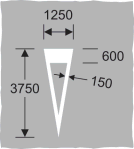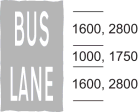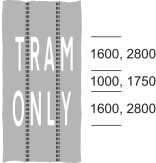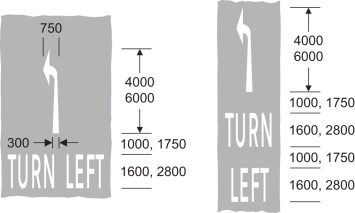- Latest available (Revised)
- Original (As made)
The Traffic Signs Regulations and General Directions 2016
You are here:
More Resources
Status:
This is the original version (as it was originally made). This item of legislation is currently only available in its original format.
PART 6Regulatory road markings
Sign table — Schedule 9, Part 6
(1) Item | (2) Description | (3) Diagram | (4) Applicable provisions in Part 8 | (5) Schedule 9 General Directions |
|---|---|---|---|---|
| 1 | Diagram 1002.1 Vehicular traffic must not proceed beyond the line when required to stop by the stop sign | 13 | 4 | |
| 2 | Diagram 1022 Approach to a road junction or level crossing at or near which is placed the marking at item 1 of this table and the stop sign | 13 | 4 | |
| 3 | Diagram 1003A Vehicular traffic must give way in accordance with the requirements in paragraph 7 of Part 7 | 1, 13 | 3 | |
| 4 | Diagram 1023A Approach to a road junction, level crossing or road narrowing at or near which is placed the marking in item 3 or 6 of this table | 13 | 12 | |
| 5 | Diagram 1003.4 Marking used in conjunction with the sign at item 6 of the sign table in Part 2 for conveying the requirements in paragraph 5 of Part 7 (Alternative sizes) | 4, 13 | 6 | |
| 6 | Diagram 1003.3 Vehicular traffic approaching a roundabout with a small central island or approaching a junction indicated by the marking shown in item 5 of this sign table should give way at, or immediately beyond, the line to traffic circulating on the carriageway of the roundabout | 13 | ||
| 7 | Diagram 1049B Boundary of a mandatory cycle lane or division of a route into that part reserved for pedal cycles and that part reserved for pedestrians conveying the requirements at paragraph 12 of Part 7 (Longitudinal marking) | 1, 9 | 1 | |
| 8 | Diagram 1049.1 Division of a route into that part reserved for pedal cycles and that part reserved for pedestrians (Longitudinal marking) | 6 | 1 | |
| 9 | Diagram 1003B Cyclists must give way in accordance with the requirements prescribed in paragraph 8 of Part 7 | 1 | ||
| 10 | Diagram 1023B Approach to a road junction on a cycle lane or track, or a place where cyclists must give way to pedestrians, at or near which is also placed the marking at item 9 | 14 | ||
| 11 | Diagram 1049A Boundary of a bus lane or other designated lane used by motor vehicles (Longitudinal marking) | 13 | 1 | |
| 12 | Diagram 1050 Direction of possible traffic movements at the end of a nearside with-flow bus lane or other designated lane, or where there is an intermediate discontinuation of the lane on the approach to a junction (alternative types) | 1 | ||
| 13 | Diagram 1050.1 Direction of possible traffic movements at the end of an off side with-flow bus lane or other designated lane, or where there is an intermediate discontinuation of the lane on the approach to a junction (alternative types) | 1 | ||
| 14 | Diagram 1048 Traffic lane reserved for buses and other vehicles as indicated on the sign at item 8 or 10 in the sign table in Part 4 | 1 | ||
| 15 | Diagram 1048.5 Road or part of a road with access permitted only for buses and other vehicles when so indicated by any of the signs at items 10, 33 to 35 and 37 to 40 in the sign table in Part 2 of Schedule 3 (Alternative types) | 1 | ||
| 16 | Diagram 1048.2A Road or part of a road with access permitted only for tramcars | 1 | ||
| 17 | Diagram 1046 No entry for vehicular traffic (Alternative types) | 13 | 1 | |
| 18 | Diagram 1046.1 Entry by vehicular traffic to a play street restricted (Alternative types) | 13 | 1 | |
| 19 | Diagram 1036.1 Vehicular traffic must turn left (Alternative types) | 13 | 1 | |
| 20 | Diagram 1036.2 Vehicular traffic must only proceed ahead (Alternative types) | 13 | 1 | |
| 21 | Diagram 1037.1 Vehicular traffic must turn right (Alternative types) | 13 | 1 | |
| 22 | Diagram 1042 Division of traffic lanes on a length of carriageway, or between the main carriageway and slip road, of a motorway or all-purpose dual carriageway road, or part of the carriageway between two lanes at a roundabout which vehicular traffic must not enter except in emergency (alternative types) | 1, 12, 13, 14 | ||
| 23 | Diagram 1013.1 Alternative methods of indicating to vehicular traffic the requirements and the warning in paragraphs 9 and 10 of Part 7 | 1, 2, 10, 13 | ||
| 24 | Diagram 1013.5 Division of traffic lanes on a length indicating to vehicular traffic the requirements in paragraph 9 of Part 7 and used in the circumstances for which the signs at items 17 to 20 in the Part 2 sign table in Schedule 11 are used | 1, 2, 11, 13 | ||
| 25 | Diagram 1043 Marking conveying the requirements in paragraph 11 of Part 7 | 1, 5 | 9 | |
| 26 | Diagram 1045 Area of carriageway, subject to two-way traffic, at a level crossing which vehicles must not enter in a manner which then causes any part of the vehicle to remain at rest within the marked area due to the presence of stationary vehicles | 1, 15 | ||
| 27 | Diagram 1045.1 Area of carriageway, subject to one-way traffic, at a level crossing which vehicles must not enter in a manner which then causes any part of the vehicle to remain at rest within the marked area due to the presence of stationary vehicles | 1, 16 |
Options/Help
Print Options
PrintThe Whole Instrument
PrintThe Whole Schedule
PrintThis Part only
You have chosen to open The Whole Instrument
The Whole Instrument you have selected contains over 200 provisions and might take some time to download. You may also experience some issues with your browser, such as an alert box that a script is taking a long time to run.
Would you like to continue?
You have chosen to open The Whole Instrument as a PDF
The Whole Instrument you have selected contains over 200 provisions and might take some time to download.
Would you like to continue?
You have chosen to open the Whole Instrument
The Whole Instrument you have selected contains over 200 provisions and might take some time to download. You may also experience some issues with your browser, such as an alert box that a script is taking a long time to run.
Would you like to continue?
You have chosen to open Schedules only
The Schedules you have selected contains over 200 provisions and might take some time to download. You may also experience some issues with your browser, such as an alert box that a script is taking a long time to run.
Would you like to continue?
Legislation is available in different versions:
Latest Available (revised):The latest available updated version of the legislation incorporating changes made by subsequent legislation and applied by our editorial team. Changes we have not yet applied to the text, can be found in the ‘Changes to Legislation’ area.
Original (As Enacted or Made): The original version of the legislation as it stood when it was enacted or made. No changes have been applied to the text.
Explanatory Memorandum
Explanatory Memorandum sets out a brief statement of the purpose of a Statutory Instrument and provides information about its policy objective and policy implications. They aim to make the Statutory Instrument accessible to readers who are not legally qualified and accompany any Statutory Instrument or Draft Statutory Instrument laid before Parliament from June 2004 onwards.
More Resources
Access essential accompanying documents and information for this legislation item from this tab. Dependent on the legislation item being viewed this may include:
- the original print PDF of the as enacted version that was used for the print copy
- lists of changes made by and/or affecting this legislation item
- confers power and blanket amendment details
- all formats of all associated documents
- correction slips
- links to related legislation and further information resources
Impact Assessments
Impact Assessments generally accompany all UK Government interventions of a regulatory nature that affect the private sector, civil society organisations and public services. They apply regardless of whether the regulation originates from a domestic or international source and can accompany primary (Acts etc) and secondary legislation (SIs). An Impact Assessment allows those with an interest in the policy area to understand:
- Why the government is proposing to intervene;
- The main options the government is considering, and which one is preferred;
- How and to what extent new policies may impact on them; and,
- The estimated costs and benefits of proposed measures.
More Resources
Use this menu to access essential accompanying documents and information for this legislation item. Dependent on the legislation item being viewed this may include:
- the original print PDF of the as made version that was used for the print copy
- correction slips
Click 'View More' or select 'More Resources' tab for additional information including:
- lists of changes made by and/or affecting this legislation item
- confers power and blanket amendment details
- all formats of all associated documents
- links to related legislation and further information resources



























